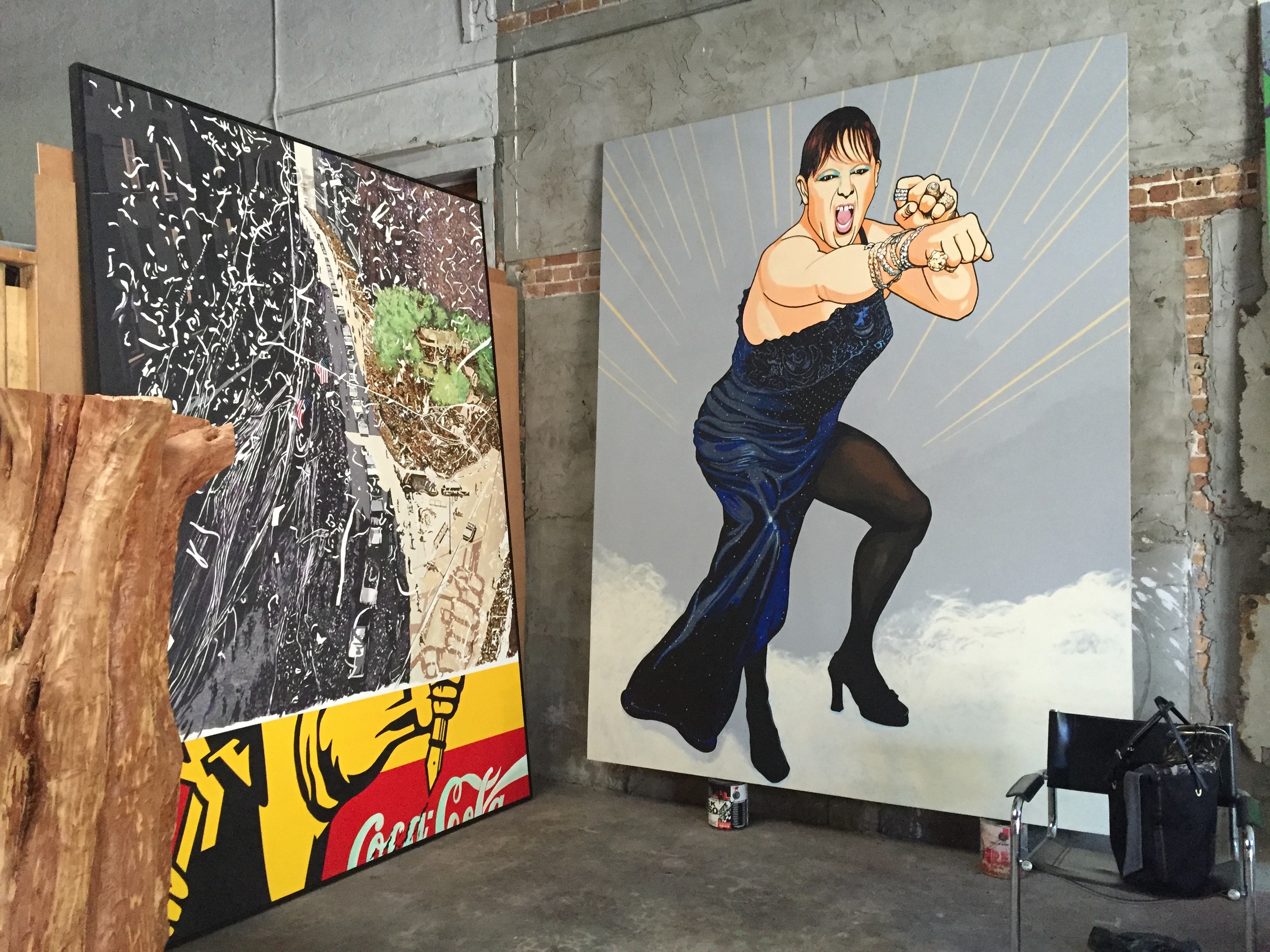Theo Wujcik: Studio Visit with Susan Johnson
Theo Wujcik, the artist, was always larger than life to me. And he remains that way, now, after his death. Most studio visits I schedule are less personal, and usually conducted by the artist. This studio tour was conducted by Theo’s widow, Susan Johnson, who is also my friend.
For nearly all the years I knew Theo, he was with Susan Johnson. I worked in Ybor City during the late 70's and most of the 80's when it was filled with artists. Very good ones: Roddy Reed, Rick Melby, John Costin, Richard Sorrentino and David Audet among others. And of course Theo. They all rented studios in the all but abandoned buildings along Seventh Avenue and neighboring streets. Rent was cheap. And they congregated in Rough Riders for happy hour.
Those were the years of the Artists and Writers Balls (they actually originated a little earlier), the founding of Guavaween and the Ybor City Artist Studio Walks. The studio artists created the walks to sell their artwork and make money before the holidays. Originally they were held only once a year on Thanksgiving weekend. Theo’s studio was a little off Seventh Avenue. Sometimes his was open, sometimes not.
Later, Theo and Susan turned their apartment into a gallery space, often drawing hundreds to openings on the corner of Eighth Avenue and Fifteenth Street. Sometimes James Rosenquist attended. Yes, Theo- and Susan too- were a little larger than life.
When Theo arrived in Tampa in 1970, he was already a Tamarind Lithography Workshop-trained Master Printer. His work was collected, and he arrived to work with USF and Graphicstudio. Many major museums including the Whitney Museum of Art still have more of his prints than his paintings. “It was after 1979, Susan states, “Theo turned away from drawing and printmaking to painting.”
Artist’s studio are very personal spaces. Theo’s was no exception. While it still feels as if he could walk in the door and take up a brush, it has changed. Susan has organized, where there was the typical studio cornucopia of discarded inspiration and beverage holders, there is now actual seating. There is also uniform storage of his paintings, labeled boxes of collages and letters, and notebooks filled with slides thanks to Susan's diligence and hard work. Susan has undertaken, after his death, what she had always wanted to do when they were together and he was in the studio: catalog, organize and archive years of exceptional work.
Susan studied art history at UCLA and has worked as a set designer, she shares Theo’s habit of “saving everything.” How fortunate they got together. Now she says she is “an archeologist,” and has immersed herself in caring for and finding a home for his archives. She is also in contact with major museums and galleries, as well as scholars, working to secure a Survey Exhibition showing the trajectory of his work.
The Ybor studio where Theo worked is still filled with some of the large- scale paintings he created during the last decades of his life. They dominate this space now, the same as before. Many were recently part of an exhibition at The Bob Rauschenberg Gallery “THEO WUJCIK: Artist’s Artist”.
During my recent studio visit, I was with members of Creatives Refired, a Tampa artist collective of woman artists (of which I am a part). Susan did an excellent job of walking us through Theo’s work processes, sharing the archived collages and work products and how “he created his own tools and worked to create a deeper black”.
She spoke of the “good fortune he turned to painting. It was a sweet ending that he painted many of his friends.” Many of the other artists with me in the studio had personal relationships with Theo, they shared poignant, bittersweet memories and personal, moving stories. Susan, who has read through journals Theo kept for decades, would sometimes recognize a shared memory. There were “goosebumps.”
I knew Theo had a long career as a printmaker, but I only knew him as a painter. As the painter who exhibited only one painting at a Gasparilla Festival of the Arts; as a contemporary of Robert Rauschenberg and James Rosenquist. As an artist who found his inspiration in the remnants of Ybor, the chain link fences, DJ cards, and yes the punk rock scene. He lived a larger life, but it was authentically his life.
I knew him as a man, husband to Susan and a father to Frankie.
Susan remains Theo's biggest champion, the keeper of his legacy. “I don’t want it to disappear.” She would like to see the Ybor studio preserved. “It is the last of its kind in Ybor. A rare experience.” The costs to preserve and catalog his work are large. Theo was not working on a computer; there are boxes of papers and journals. Even his slides need to be scanned for safekeeping.
Susan has established a non-profit to offset the costs of the preservation expenses. She hopes, and intends that the Rauschenberg Gallery show will be just the beginning of public exhibitions of his artwork. Currently she is in talking with a publisher regarding the printing of a monograph and with museums about a Survey Exhibition. Certainly, she thinks it would be wonderful to have the work shown locally. Theo had many local admirers and collectors of his work.
Susan’s work at the studio will continue through at least the end of the year. Selected Theo Wujcik artwork is still available for sale.
Contact Susan Johnson @ Johnson-wujcik@icloud.com. See more about Theo Wujcik @ theowujcik.com.





